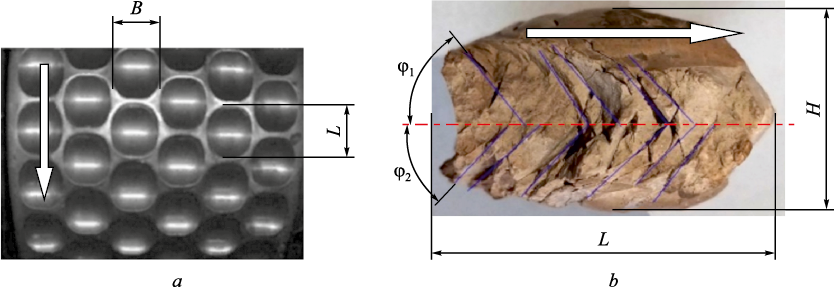Scroll to:
Cracking in MgO briquettes
https://doi.org/10.17073/0368-0797-2023-1-86-88
Abstract
This paper examines the crack geometry of briquettes in magnesium oxide (MgO), a slagging material widely used in iron and steel making applications. Geometry measurement data and crack layout in briquettes are produced by roll briquetteizing. Cracking in briquettes is likely due to the workflow of roll briquetteizing. This defect affects the strength of briquettes and yield ratio (plus productivity rate) during briquetteizing using roll baling presses. A number and angles of cracks in respect to the briquetteizing direction were identified in accordance with photos of briquette side surfaces using graphical software.
Keywords
For citations:
Babailov N.A., Loginov Yu.N., Polyanskii L.I. Cracking in MgO briquettes. Izvestiya. Ferrous Metallurgy. 2023;66(1):86-88. https://doi.org/10.17073/0368-0797-2023-1-86-88
MgO (its content in slag varies from 10 to 20 %) is a mandatory component for steelmaking slags. Quantities of MgO in slag control its viscosity. MgO enhances slag sulphur-scavaging capabilities, as well as the lining strength of steel-making furnaces and ladles.
Roll pressing techniques are commonly used [1, 2] in order to prepare powdered materials for metallurrgical processing. Roll presses have rolls equipped with cells of one shape or another [3]. Transverse and diagonal cracks are formed when pressing and rolling powder-metallurgical materials. This defect is commonly seen in powder metallurgy [4, 5]. The strength properties of products are governed by this defect.
The aim of this work is to define the geometry and layout of the cracks subject to formation at high pressing pressure in the event of dry briquetteizing of cryolite, aluminium fluoride, MgO, etc.
External view of cells on the roll (a) and magnesian briquette (b) (the image is rotated), |
Ten magnesian briquettes were studied after briquetteizing using roll presses in rolls (or bands) with mechanically processed cells (Fig. а). The particle-size composition varies from 0 to 1 mm. Briquette density is 2,100 kg/m3. Falling strength of briquettes ranges from 75 to 92 %. The briquette dimensions are as follows: length L = 32 ± 1 mm; height H = 19.5 ± 0.5 mm; breadth B = 29 ± 1 mm. In this paper the so-called “dry briquetteizing” method (i. е. briquetteization with no binder or water) is applied. During briquetteizing the baling press roll gap is 5 mm. Fig. b shows an image of the MgO briquette side surface which demonstrates clearly visible cracking.
As seen in the figure, the cracks are positioned close to the rear portion of the briquette. It was previously shown that the roll mill cell has a pressurizing side and an opposing side of the process circuit. Whereas high pressure is created on the pressurizing side, this side is involved in creating the rear portion of the briquette. In this specific case, cracking was formed in the high pressure area, i.e. these cracks are induced by over-pressure..
Using our graphical software, we calculated average crack angles in the top and bottom of a briquette (φ1 = 49.2° and φ2 = 48.4°). The visible cracks in briquettes amount to 5 – 6 pcs. Average crack angle in a briquette is 48.8° (this value is within 45 – 60°.) Normally, the formation of cracks with an angle of approx. 45° to the = axis is associated with maximum tangential stresses in place.
Conclusions
The findings reveal that cracks in briquettes are formed in the rear portion of a briquette i. e. where high pressure exists. One recommendation for the remedying of such defects (over-pressing induced cracking) obtained is to increase the gap between rolls of briquetting press.
References
1. Dec R.T., Zavaliangos A., Cunningham J.C. Comparison of various modeling methods for analysis of powder compaction in roller press. Powder Technology. 2003; 130(1–3): 265–271. http://doi.org/10.1016/S0032-5910(02)00203-6
2. Simonov K.V., Luzin A.G., Bocharov L.D., Fleer S.A., Gol’dberg I.A., Timofeev N.N., Shumeiko R.M. Briquetting caustic magnesite on industrial type smooth rollers. Refractories. 1974; 15: 185–193. https://doi.org/10.1007/BF01286260
3. Bayul K.V. Effect of the geometrical parameters of roll press forming elements on the briquetting process: Analytical study. Powder Metallurgy and Metal Ceramics. 2012; 51: 157–164. https://doi.org/10.1007/s11106-012-9411-8
4. Eremin A.Ya., Babanin V.I., Kozlova S.Ya. Establishing the requirements for indices characterizing the mechanical strength of briquets with binders. Metallurgist. 2003; 47(11–12): 437–446. https://doi.org/10.1023/B:MELL.0000019002.95148.fa
5. Barsukov V.G., Krupicz B., Barsukov V.V. Tribomechanical analysis of interlayer shear and surface crack nucleation processes in compacted disperse materials. Journal of Friction and Wear. 2015; 36: 112–117. https://doi.org/10.3103/S1068366615020026
6. Babailov N.A., Loginov Yu.N., Polyansky L.I. Influence of the gap between the rolls on parameters of the roll briquetting of metallurgical lime and magnesium oxide. Chernye Metally. 2022; (6): 9–14. https:/doi.org/10.17580/chm.2022.06.02
About the Authors
N. A. BabailovRussian Federation
Nikolai A. Babailov, Cand. Sci. (Eng.), Senior Researcher of the Laboratory of Applied Mechanics
34 Komsomol’skaya Str., Yekaterinburg 620049, Russian Federation
Yu. N. Loginov
Russian Federation
Yurii N. Loginov, Dr. Sci. (Eng.), Prof. of the Chair “Metal Forming”
19 Mira Str., Yekaterinburg 620002, Russian Federation
L. I. Polyanskii
Russian Federation
Leonid I. Polyanskii, Director
54 Studencheskaya Str., Yekaterinburg 620912, Russian Federation
Review
For citations:
Babailov N.A., Loginov Yu.N., Polyanskii L.I. Cracking in MgO briquettes. Izvestiya. Ferrous Metallurgy. 2023;66(1):86-88. https://doi.org/10.17073/0368-0797-2023-1-86-88

































